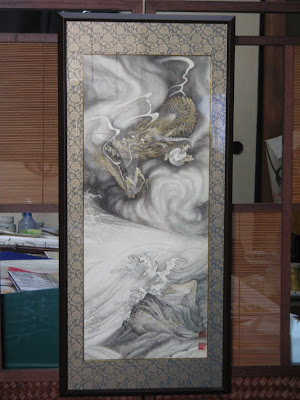














Traditional kimono makers, who have gone through the traditional apprenticeship and all the traditional training, are, I suppose, a dying breed. There are not many people now, who want to devote their life to an art where the financial rewards are probably meagre, and the work time consuming, repetitive, lonely and not always much fun.
I first met SK when we were both submitting work for an exhibition. I wasn't sure where to go, and she helped me. I do dyeing as a hobby, but SK works as a weaver. She graduated from a fashion school and then apprenticed herself to a craftsman weaver in Nagano, rather than to a famous name in Tokyo. She worked for him for several years, for board and lodging, and her work included delivering threads and orders to farmers' wives, and later picking up the finished woven bolts. She also had time to work on her own, first plain and then striped bolts. When I met her she was living near Tokyo, but then she decided to move to Shizuoka, and she built a house with a studio, where she has lived since. She visits Tokyo for occasional exhibitions.
What I admire about SK is the fact that she starts at the very beginning, growing the plants and extracting the dyes to make her work. She also does a fantastic job of egasuri, picture ikat, of traditional Japanese motifs. They are always sensitive and delicate works, that take an enormous amount of time, sometimes several months, for one kimono. Since I met her she has won several awards for her work, and has had it presented in national exhibitions. She remains unwired and growing, dyeing and weaving her beautiful art.
NS I met completely by accident. I was wearing a kimono in a restaurant and he was staring at me. He gave his name card to the restaurant owner, who then passed it on, saying that if I liked kimono I should go and visit his studio. Of course, I called him the next day, and we have been friends for over 20 years.
He came from the countryside in north Japan, and when he graduated high school, he got on a train for Tokyo the next day, almost never to go back. Through family connections he was apprenticed to Arai Terutaro, a famous Tokyo Yuzen dyer. At first he ran errands for a lot of the time. He was the bottom of the pile and there were several more advanced apprentices. However, he was precociously brilliant at the drawing and tracing work, that is a part of the essential yuzen dyer's training. In his 20s and 30s he was getting to be a leading light and had a show at the famous Hotel Okura. He had commissions from well-connected people in the political and also in the geisha world. He was doing well and then suddenly he got sick. He was hospitalized for a long time, and disappeared from public life.
When I saw his yuzen, I thought it was the most beautiful yuzen I had ever seen. He does not need to embellish with gold lines or much embroidery. His use of colours and shading are superb. I have never seen any yuzen like his on sale in shops or even at kimono sales. He refuses to enter any national exhibitions, and just wants to concentrate on his art. However, with funding from the Japan Foundation, I managed to pursuade him to come and teach a workshop on yuzen to fashion students at Manchester Metropolitan University. It was a major operation to make him a passport and a bank account, and to take him away from Tokyo, on a major journey and look after him for three weeks. The workshop was a great success.
Through NS I met FC. She is also a weaver, in Tokyo, who has a workshop and about ten apprentices who work for her. She too grows and dyes the threads herself, and also has a small indigo pot, in the garden. I spent a pleasant afternoon with her, and we all tried on many different kimono lengths, to see the effect. The cloth has double warps and wefts which makes the complex kind of squared or checked effect.
FC has her two daughters working for her, and all the other apprentices to support, so she is more concerned with making contacts and marketing her work. She seems to be actively involved in neighborhood events.
After we made a huge mess, trying on lots of her roles of cloth, she got out some snacks and beer, and we were further treated with beautiful foods and tastes after feasting our eyes on her lovely work.

Wow that workshop sounded great! If you plan on doing something like that again in future you much let me know.
ReplyDelete